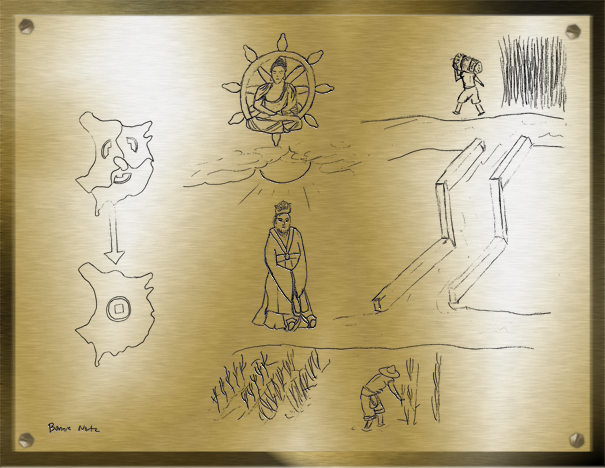| Time Period | Sui Dynasty |
| Geographical Region | Eastern portion of modern-day China |
| List of Symbols |
|
My plaque deals with the Sui Dynasty, which lasted from years 589-618 AD. Based on project description, I designed this plaque based on the hypothetical situation that it would have been made by someone in the Sui court wanting to leave a good impression of the Sui dynasty for posterity. Therefore, the plaque’s primary theme was that of unification, and the symbols in the plaque are gravitating around the symbol in the center, the emperor. Viewers of the plaque would presumably be able to find record of the traditional clothing worn at the time, so they would learn that the clothing worn by the central figure was worn by courtiers, and because of the placement of the figure directly in the center of the plaque, they could infer its importance and therefore deduce that it is probably a depiction of the emperor. The sun and clouds above the robed figure also lend significance to the emperor figure. The belief that the emperor was the son of heaven existed in China since antiquity, and it gives the emperor a powerful air of cultural and moral authority. In the plaque, this is represented by the sun shining down on the emperor, showing that heaven smiles upon him.
To the left of the emperor is a depiction of the geographical unification of the empire. In the top-most of the two diagrams is the region split into four kingdoms, and in the diagram below it, they have all been united into one dynasty. This is further symbolized by the image of the Sui coin. In the top diagram, the coin is broken up among the kingdoms, whereas it is shown as one whole coin in the bottom. This transformation from pieces to a whole helps symbolize geographic as well as cultural unification, which was the goal of the Sui. When the Sui united the empire, the culture of the north and the south were quite different from each other, primarily because of the heavy influence of Turko-Mongol people in the north. Therefore, the Sui took measures to unite the empire not only geographically, but also culturally. Many of these will be described below, and they are broadly symbolized in this section of the plaque by the image of a coin transforming from broken pieces into a unified whole.
Above the emperor is the figure of a meditating Buddha, sitting within an eight-spoked wheel. Both of these images are iconic symbols of Buddhism, which the Sui government patronized in order to try to gain the support of the people. Because of the donations of the emperor, Buddhist monasteries, and Buddhism itself, flourished in the empire during this time.
Below and to the right of the emperor is a depiction of the Grand Canal, built during the Sui Empire. Yet another means of unification, the Grand Canal connected the Yangzi River in the south to the Yellow River in the north. One primary reason for having the canal built was to transport rice from the south to the capital in the north. Therefore, the south is represented by the rice paddies, depicted to the bottom of the plaque, and the north is represented by the wheat fields at the top of the plaque. Because the Grand Canal is a man-made structure, its banks are represented by straight, linear walls contrasting with the rounded, natural banks of the rivers. The Grand Canal also served as another piece of political unification. As mentioned earlier, the culture of the north and the south of China had grown to be quite different from one another, and they had been ruled by different governments since the Han dynasty fell in 220 AD. Therefore, with the Grand Canal serving as a method of transportation between the north and the south, it also served as a political symbol that the two regions were now the same under the Sui.
Finally, I wanted to discuss a number of symbols not depicted in this plaque. Given the situation that a person within the Sui government created this plaque for the Sui dynasty to be remembered favorably, there were a number of actions of the Sui that were not as laudable or popular. The second emperor of Sui in particular, came to be infamous for his extravagance, especially with the way he had the capital at Luoyang rebuilt. Compounding this were the military campaigns he began against the people in modern Vietnam, modern Korea, and the Eastern Turks. These campaigns were unpopular and unsuccessful, and were the primary motivation for the rebellions that toppled the Sui dynasty. However, since these events do not cast the Sui in as favorable a light as its successes in unification, they are left out from this plaque.
The overall theme of this plaque is that of the unification of the Chinese empire, which was the main accomplishment of the Sui dynasty. The Sui unified the empire not only geographically, but also culturally and politically with the state promotion of Buddhism and the building of the Grand Canal. Although the Sui only ruled for three decades, the effects of their unification lasted for centuries.
 BONNIE NORTZ is a double major in Mathematics and Linguistics, with a minor in Computer Science. This year she is a Take Five student for Chinese Language and Art. She is also involved in SOCKS and Swing Dance Club. More by Bonnie
BONNIE NORTZ is a double major in Mathematics and Linguistics, with a minor in Computer Science. This year she is a Take Five student for Chinese Language and Art. She is also involved in SOCKS and Swing Dance Club. More by Bonnie
